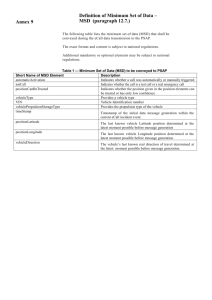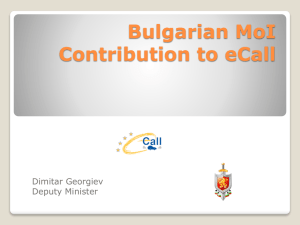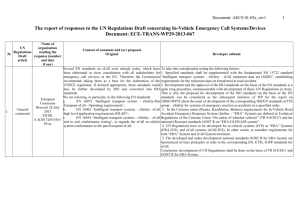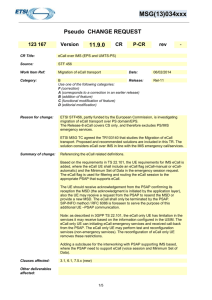ECall- Newly emerging ecal safety equipment standard and algorithms
advertisement
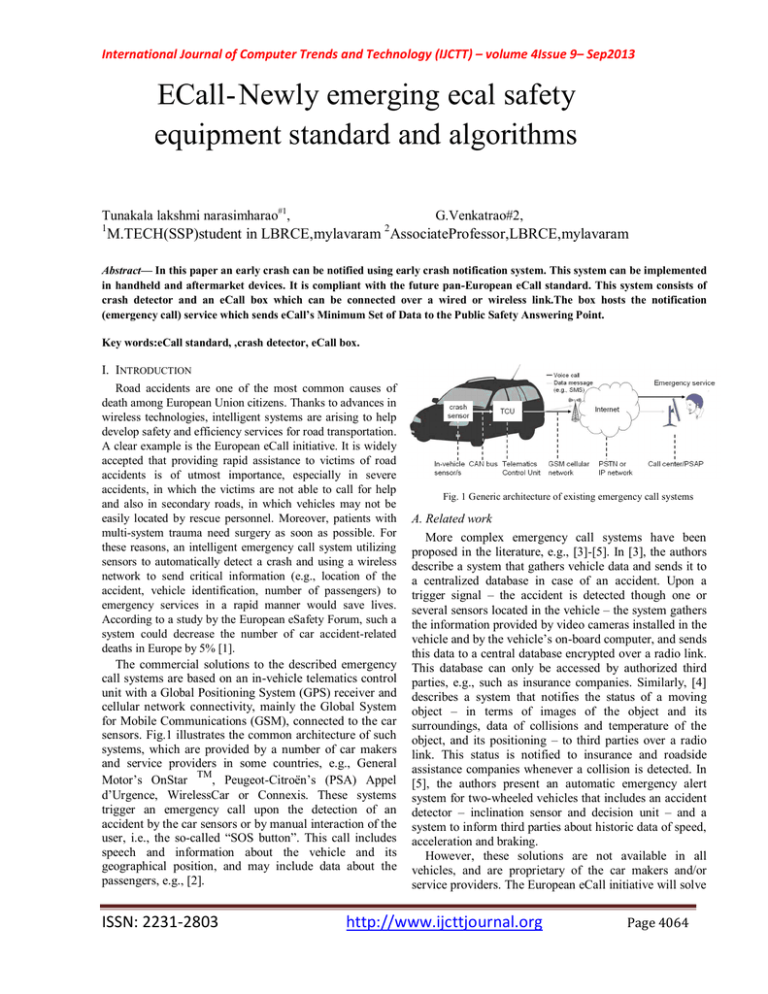
International Journal of Computer Trends and Technology (IJCTT) – volume 4Issue 9– Sep2013 ECall- Newly emerging ecal safety equipment standard and algorithms Tunakala lakshmi narasimharao#1, 1 G.Venkatrao#2, 2 M.TECH(SSP)student in LBRCE,mylavaram AssociateProfessor,LBRCE,mylavaram Abstract— In this paper an early crash can be notified using early crash notification system. This system can be implemented in handheld and aftermarket devices. It is compliant with the future pan-European eCall standard. This system consists of crash detector and an eCall box which can be connected over a wired or wireless link.The box hosts the notification (emergency call) service which sends eCall’s Minimum Set of Data to the Public Safety Answering Point. Key words:eCall standard, ,crash detector, eCall box. I. INTRODUCTION Road accidents are one of the most common causes of death among European Union citizens. Thanks to advances in wireless technologies, intelligent systems are arising to help develop safety and efficiency services for road transportation. A clear example is the European eCall initiative. It is widely accepted that providing rapid assistance to victims of road accidents is of utmost importance, especially in severe accidents, in which the victims are not able to call for help and also in secondary roads, in which vehicles may not be easily located by rescue personnel. Moreover, patients with multi-system trauma need surgery as soon as possible. For these reasons, an intelligent emergency call system utilizing sensors to automatically detect a crash and using a wireless network to send critical information (e.g., location of the accident, vehicle identification, number of passengers) to emergency services in a rapid manner would save lives. According to a study by the European eSafety Forum, such a system could decrease the number of car accident-related deaths in Europe by 5% [1]. The commercial solutions to the described emergency call systems are based on an in-vehicle telematics control unit with a Global Positioning System (GPS) receiver and cellular network connectivity, mainly the Global System for Mobile Communications (GSM), connected to the car sensors. Fig.1 illustrates the common architecture of such systems, which are provided by a number of car makers and service providers in some countries, e.g., General TM Motor’s OnStar , Peugeot-Citroën’s (PSA) Appel d’Urgence, WirelessCar or Connexis. These systems trigger an emergency call upon the detection of an accident by the car sensors or by manual interaction of the user, i.e., the so-called “SOS button”. This call includes speech and information about the vehicle and its geographical position, and may include data about the passengers, e.g., [2]. ISSN: 2231-2803 Fig. 1 Generic architecture of existing emergency call systems A. Related work More complex emergency call systems have been proposed in the literature, e.g., [3]-[5]. In [3], the authors describe a system that gathers vehicle data and sends it to a centralized database in case of an accident. Upon a trigger signal – the accident is detected though one or several sensors located in the vehicle – the system gathers the information provided by video cameras installed in the vehicle and by the vehicle’s on-board computer, and sends this data to a central database encrypted over a radio link. This database can only be accessed by authorized third parties, e.g., such as insurance companies. Similarly, [4] describes a system that notifies the status of a moving object – in terms of images of the object and its surroundings, data of collisions and temperature of the object, and its positioning – to third parties over a radio link. This status is notified to insurance and roadside assistance companies whenever a collision is detected. In [5], the authors present an automatic emergency alert system for two-wheeled vehicles that includes an accident detector – inclination sensor and decision unit – and a system to inform third parties about historic data of speed, acceleration and braking. However, these solutions are not available in all vehicles, and are proprietary of the car makers and/or service providers. The European eCall initiative will solve http://www.ijcttjournal.org Page 4064 International Journal of Computer Trends and Technology (IJCTT) – volume 4Issue 9– Sep2013 this problem by embedding an in-vehicle eCall platform that will launch an automatic voice and data call to the pan-European emergency service (E112) in case of an accident. This service, which is expected to be offered in all new four-wheeled vehicles by 2010, will provide E112 with information about the vehicle and its location. The eSafety Forum’s eCall Driving Group is responsible for eCall’s implementation recommendations [6]. B. Organization of the paper ISSN: 2231-2803 http://www.ijcttjournal.org Page 4065 International Journal of Computer Trends and Technology (IJCTT) – volume 4Issue 9– Sep2013 In this paper we explore the possibility of implementing an eCall-compliant automatic crash detection and notification service for portable and nomadic devices, which shall render eCall available for two-wheeled and second-hand vehicles. The remainder of the paper is organized as follows. Section II overviews the future European eCall standard. In Section III we describe our proposed emergency call system, which is assessed experimentally in Section IV. Finally, in Section V we draw conclusions and outline future work in the field. II. ARCHITECTURE AND STANDARDIZATION OF ECALL The eCall architecture [6] uses the GSM cellular network to communicate between the vehicle in incident and the Public Service Answering Point (PSAP). The future eCall service will use the single pan-European emergency call number E112 to ensure that eCall has full roaming capabilities in Europe. Fig. 2a depicts the elements of the eCall architecture defined by the eCall Driving Group: the vehicle, the network and the PSAP, and shows the flow of voice and data calls established between the vehicle and the PSAP in case of an emergency. a) TM audio path to the PSAP operator. Note that the OnStar system, already deployed in the USA, uses this solution to transmit emergency data. An alternative solution is to send eCall data over an SMS, which is a reliable, widely-supported, low-cost messaging system that could support the transmission of MSD’s 140 bytes. Early eCall trials using SMS have been realized in France, Germany and Finland, and this data transmission scheme is also used by a number of car manufacturers, i.e., PSA, BMW and Volvo, that is, in around 1 million cars circulating in 14 European countries. In para-llel, automobile Original Equipment Manufacturers are now proposing embedded solutions of the eCall service, which comply with both the automotive industry and the future eCall standards. These solutions are called eCall In-Vehicle Systems (IVS). Fig. 2b shows the functional architecture of an eCall IVS [9] with in-band modem based MSD transmission [8]. III. PROPOSED EMERGENCY CALL SYSTEM This section focuses on an eCall-compliant, portable implementation of an automatic emergency service. Fig. 3 illustrates this implementation, and relates it to the generic emergency call architecture depicted in Fig. 1. The differences between both figures are highlighted in bold and in italics. to locate and assist the accident victims more quickly. Once the MSD has been sent, the in-band modem will open the b) Fig. 2 Architecture of a) the eCall service and b) an eCall IVS. Sources: [6, 9] The standardization activities related to the technical solution for the implementation of the architecture in Fig. 2a cover two main issues: the transport protocol by which the Minimum Set of Data (MSD) will be sent via the cellular network to the PSAP, and the content and format of the MSD. The European Telecommunications Standards Institute (ETSI) is in charge of developing supporting standards for eCall. Currently, CEN/TC 278 WG15 (eSafety) is leading the definition of the MSD, while the MSD transmission is being defined by the ETSI-MSG and the 3GPP standardization bodies. The MSD message [7] amounts to a maximum of 140 bytes, its main contents being: the timestamp and geographical position of the accident, eCall activation indicator (manual or automatic), vehicle type and identification number (VIN), number of passengers and optional data. ETSI’s MSG and 3GPP are standardizing the transmission of eCall data. The preferred solution is based on an in-band modem and application [8]. The MSD is transmitted to the PSAP in the audio band as soon as the emergency voice call is established (Fig. 2a). This will enable the emergency services ISSN: 2231-2803 http://www.ijcttjournal.org Page 4066 International Journal of Computer Trends and Technology (IJCTT) – volume 4Issue 9– Sep2013 Fig. 3 Experimental implementation of the proposed emergency call system A. Crash sensor An accelerometer was chosen as the crash sensor because it is a low-cost solution capable of detecting frontal, lateral and rollover crashes. At present, acceleration sensors are used to interpret the severity of front and rear impacts by assessing four-wheeled vehicle speed. Typically, such vehicles also use pressure sensors to react to side impacts by monitoring changes in air pressure in vehicle body cavities, as well as other in-car sensors. Newly developed sound sensors, such as the Crash Impact Sound Sensor (CISS) [10], which detect vibrations in materials and judge the amount of deformation being experienced, were also interesting candidates but were not chosen because they need to be mounted to a vehicle's chassis. Note that in our system, the crash sensor must be located in a suitable place in the vehicle, e.g., at the front in a car, below the seat in a motorbike or in the helmet for twowheeled vehicles; and must transmit acceleration data to the device hosting the eCall service, e.g., the car’s on-board computer or a mobile phone, which processes the data and sends the eCall message (Fig. 3). From now on, this device will be called eCall box. The sensor could also be embedded in the box but this would require the latter to be fixed in the vehicle, which is difficult for handheld devices and also for two-wheeled vehicles. Fig. 4 illustrates suitable placements of the crash sensor and the eCall box on a two-wheeled vehicle. ISSN: 2231-2803 http://www.ijcttjournal.org Page 4067 International Journal of Computer Trends and Technology (IJCTT) – volume 4Issue 9– Sep2013 type with the decision rules depicted in Fig. 5. If acc_d has no peaks, a “no crash” indication is issued. Fig. 4 Implementation of the crash sensor and eCall box on a motorbike B. eCall box The eCall box is a communications-enabled device, where the communications technologies shall encompass at least GSM and may include Short-Range Communications (SRC) if the crash sensor is physically separated from the eCall box hosting the proposed emergency call service. This service is a piece of software that can be installed in any kind of box, that is, an aftermarket device connectable or not to the vehicle’s network (CAN) and/or on-board computer; a portable device (PDA, laptop); or a mobile phone (Fig. 4), and communicates with the crash sensor through a wired or wireless link (Fig. 3). This scheme is especially useful for two-wheeled vehicles and second- hand cars, which have no in-built emergency system and are out the scope of the future European eCall standard [6]. Our emergency call service consists of three processes: the detection of the accident, the composition of the MSD and the transmission of the MSD over a cellular (GSM) radio link. The automatic detection of an accident is achieved by permanent listening to the crash sensor. Whenever the sensor is in motion, it sends data to the eCall box, which keeps the most recent t_s msec of velocity and acceleration data in its memory. The emergency service constantly scans this data for ‘sharp spikes’ in the acceleration values. If a peak above a certain threshold is found, it is analyzed and compared to the typical acceleration profiles of various types of crashes (see Section IV.C). In case of an accident, this information is added to the MSD, and the emergency call is placed. Since eCall’s service emergency call end -to-end delay is bounded to tens of seconds [6], this detection process includes a simple, rapid algorithm for determining the type of crash. Fig. 5 Crash detection algorithm flowchart This algorithm takes into account the acceleration in the x, y, and z directions (acc_x, acc_y and acc_z, respectively) and the roll value (r_v), which returns the number of radians the sensor has rotated from the upright position. Each array of acc_* variables contains the most recent t_s msec of sensed data. The algorithm focuses on peaks in these arrays, that is, areas where the values rise above a given threshold (*_limit) and then suddenly descend past that threshold. First, the algorithm detects a crash with a peak (value above d_limit) in acc_d=(acc_x2+acc_y2)1/2, and then determines the collision ISSN: 2231-2803 http://www.ijcttjournal.org Page 4068 International Journal of Computer Trends and Technology (IJCTT) – volume 4Issue 9– Sep2013 Once the type of crash has been determined, the process stops storing acceleration data but continues to store roll data. After a delay t_d (configured depending on the time needed by the vehicle to come to rest), r_v is read to determine if the vehicle rolled over at any point during the collision. The most recent r_v values can be sent in the MSD or in a secondary message to the PSAP to inform if the vehicle is resting on its roof (for four-wheeled vehicles) or side, which would allow for the advance allocation of rescue equipment and personnel. As for the composition of the MSD, this message contains the information about the accident that is sent to the emergency services (PSAP). As described in Section II, the eCall standard requires, at least, an identification number of the vehicle, timestamp of the accident, the GPS coordinates of the car at the time of the crash and the number of passengers. Our proposed system, as most emergency systems found in the literature, is capable of providing the basic MSD data. The geographic location is provided either by the Global Positioning System (GPS) coordinates or cellular-network triangulation, for the eCall box can be located in a handheld device that may not have a built -in GPS receiver. The vehicle-related information included in the MSD is obtained from a configuration file stored in the eCall box. This information can be either filled in by the user at the time of purchase of the service or, if the vehicle is enabled with wireless connectivity, e.g., Bluetooth or WiFi (only for WiFienabled handheld devices), the system can obtain it from the onboard computer. Thanks to SRC communications, our proposed system is capable of detecting the number of Bluetooth-active handheld devices in the vehicle, which provides an estimation of the number of passengers involved in the accident. As described before, if the device hosting the eCall box is connected (wired or wirelessly) to the vehicle’s on-board computer of the vehicle, information about the number of passengers will be highly accurate, since four-wheeled vehicles are enabled with pressure sensors in seats and seatbelt sensors, from which the number of passengers can be inferred. Modern four-wheeled vehicles have many built -in sensors, which make it possible to gather information about the state of the vehicle at the time of the crash. This extra information would be very useful to the proper allocation of emergency services upon receipt of the eCall MSD. Therefore, in addition to the basic MSD data, our proposed system gathers data about the accident and about the passengers, whose amount and accuracy depends on the capabilities of the device hosting the eCall box: The crash sensor provides information about the type and severity of the crash. The accelerometer is capable of detecting frontal, lateral and roll-over crashes (type), and the acceleration profile of the crash indicates the severity of the accident. Section IV.C describes the experimental results of crash detection with an early prototype. Passenger information beyond the number of passengers is also very useful for emergency services. Valuable data can be obtained from the handheld devices of passengers using suitable Bluetooth profiles, e.g., basic medical record (blood type, allergies), age or sex, depending on these devices. ISSN: 2231-2803 The above information is included in the 73-byte “optional data” field of the MSD. Finally, the transmission of the MSD to the PSAP is done as specified in the eCall standard [6]. http://www.ijcttjournal.org Page 4069 International Journal of Computer Trends and Technology (IJCTT) – volume 4Issue 9– Sep2013 IV. EXPERIMENTAL IMPLEMENTATION AND RESULTS The proposed system offers three fundamental advantages: 1) it can be implemented on any device, making it suitable for second-hand cars and two-wheeled vehicles, which are out of the scope of the eCall standard and for which an eCall solution need not follow the automotive industry standards, 2) it may provide optional data to emergency services obtained from the passenger’s handheld devices, and 3) it is compliant with the European eCall standard. A first prototype was implemented at Telefónica I+D’s labs and is described in Section IV.A. However, our solution also presents potential drawbacks. Sections IV.B analyses the main performance bottleneck the eCall box implementation in a handheld device, i.e., quality and reliability of the wireless link between the crash sensor and the box. Section IV.C discusses the effectiveness of accelerometers as the only crash sensor. As depicted in Fig. 3, the connectivity between the crash sensor and the eCall box in our proposed system can be wired A. Test setup Fig. 6 depicts our test setup, which involves all the elements depicted in Fig. 3: a crash sensor (accelerometer) in TM the form of a Wii Remote device; an eCall box in the form of a PC running Linux OS, containing the proposed emergency call service and the WiiRemoteJ libraries [11]; a PSAP in the form of a web -based application; connectivity between the crash sensor and the eCall box in the form of a Bluetooth link; and connectivity between the box and the PSAP in the form of Telefónica I+D’s Ethernet local area network (LAN). Fig. 6 Main elements of the test setup (left) and PSAP detail (right) TM The Wii Remote (a in Fig. 6) was chosen because it is an off-the-shelf solution that integrates a built-in accelerometer with the characteristics described in Section III.A, and it is enabled with Bluetooth capabilities. The proposed emergency call service (b ) was implemented in Java according to Section III.B and was installed in an eCall box emulated by a standard PC (c) running Linux. The Bluetooth software connectivity between the Wii TM Remote and the PC was provided by BlueZ [12] and a Bluetooth USB adapter (d in Fig. 6). For simplicity, the communication between the eCall box and the PSAP (emulated by a PC, e) only involved the data call. The MSD message was sent through a standard HTTP call over a LAN. That is, upon the detection of a crash, the emergency call service opens a connection to the URL where the PSAP web application (f) is running. Second, the MSD is sent through the established channel in hexadecimal format. Last, the PSAP sends an MSD acknowledgment to the eCall box [9] and displays the information of the MSD. B. Bluetooth link quality ISSN: 2231-2803 http://www.ijcttjournal.org Page 4070 International Journal of Computer Trends and Technology (IJCTT) – volume 4Issue 9– Sep2013 or wireless. Since wireless access is more challenging in vehicular environments, we analyzed Bluetooth connectivity between the crash sensor and the eCall box, which must be permanently interconnected. The Bluetooth-USB dongles tesTM ted to connect the Wii Remote with the PC were class-1 Linksys USBBT100 [13] and class-2 Conceptronic CBTU2 [14]. The class-1 dongle showed an excellent behaviour under the conditions in Table I, which is in line with the results obtained in [15], while the performance of the class-2 was poorer. Here we describe the link quality results of the latter. The Link Quality (LQ) is an 8-bit unsigned integer that evaluates the perceived link quality at the receiver. It ranges from 0_to 255_(maximum_signal_strength). LQ is constantly updated as packets are received. Using BlueZ [12], LQ of the sensor-box connection was monitored in the presence of disturbances emulating the harsh environment in which the proposed system would operate. These conditions, listed in Table I, include the vibration of the motor, the interference from other Bluetooth devices, and the interference from physical barriers such as metallic or plastic objects. Each condition was tested in 10 trials, with 2504 measurements each. After each trial, the Bluetooth connection was restarted. Condition(s) under test 1. Line of sight 2. Thick plastic 3. Metal box 4. Vibration 5. 3 and 4 Distance sensor-dongle 1m 1m 1m 1m 1m Bluetooth devices detected 5 5 16 16 3 observed by an accelerometer depends, among other factors, on the placement of the crash sensor in terms of the position of its axes and on whether it is rigidly mounted in the vehicle. Average signal strength (% of max) 99.52 98.44 82.20 98.40 88.79 Table I. Tested conditions and results using a class-2 Bluetooth dongle Fig. 7 Bluetooth link quality over time (class-2 dongle) Since the sensor and the eCall box must be permanently connected during a trip, we tested whether the longevity of the Bluetooth connection had an effect on the emergency service. To this end, the system was left running for a total of 13.88h (50.000 sec), with LQ measurements every 10 sec. The results in Fig. 7 show very little impact of the connection duration on LQ. Besides, throughout all the tests the Bluetooth connection was never dropped, and the Bluetooth link was established within a few seconds, which is the expected behavior of the protocol (including lower LQ values during establishment, see Fig. 7) . Overall, the lowest signal strength measured was around 18% below the maximum, which allows for normal operation of our system. A comprehensive study of LQ and other Bluetooth signal parameters can be found in [15]. C. Crash detection As indicated in [16], the response of a vehicle to an impact ISSN: 2231-2803 http://www.ijcttjournal.org Page 4071 International Journal of Computer Trends and Technology (IJCTT) – volume 4Issue 9– Sep2013 We placed the crash sensor as indicated in Fig. 8. This figure also illustrates the types of crashes characterized here. eCall standards currently under definition. Experimental results with an early implementation show its Fig. 8 Axes of the crash sensor and crash types under study Collision pulse characteristics generally consist of shape, amplitude and duration. Fig. 9 shows the impact response TM measured by WiiRemote ’s accelerometer for the crash types in Fig. 8, emulating ‘brought-in’ sensor locations in four- and twowheeled vehicles, e.g., on the car’s dash or behind the rear plate in a motorbike. Note that vehicle’s structural engagement influences the acceleration response. Our results comply with the pulse shapes in [16] regarding non-rigidly mounted accelerometers. According to this characterization, the values of the algorithm thresholds were set to d_limit = 200 and y_limit = -19. As for the duration (length) of the acceleration array (acc_*) used by the detection algorithm described in Section III.B, t_s = 2000 msec. Fig. 9 Characterization of frontal and lateral crashes with acc_x and acc_y We also verified the success rate of the simple crash detection algorithm proposed in Section III.B measuring the acceleration time history (acc_*) of the sensor with repeated tests of the single -axis crash types of Fig. 8. The algorithm detected correctly the crash types under test in above 90% of the trials, which is a very promising result for our proposed single-sensor system, although enhanced tests with the sensor mounted in different locations of two-wheeled and fourwheeled vehicles are needed to refine the algorithm and its thresholds. The interested reader is referred to [16] for a comprehensive analytical and experimental characterization of collision pulse shapes with accelerometer data. V. CONCLUSIONS AND FUTURE WORK The implementation scenarios of the future eCall service are still under discussion in the European Union [17]. Embedded solutions (IVS) assure reliability and robustness, while ‘brought-in’ solutions allow for bundling with other services, solve life-time issues and simplify SIM management. We have presented a novel brought-in solution not only for aftermarket but also for nomadic devices. Moreover, our solution can also provide optional data to emergency services obtained from the crash sensor (accelerometer) and the passengers’ handheld devices, while keeping total compliance with the European ISSN: 2231-2803 http://www.ijcttjournal.org Page 4072 International Journal of Computer Trends and Technology (IJCTT) – volume 4Issue 9– Sep2013 viability in a worst-case scenario (wireless link between the sensor and the eCall box) in terms of Bluetooth link quality and reliability in case of long duration, and crash detection. Future work involves empowering the prototype with the features necessary to run the eCall service in a fully nomadic scenario. That is, implementing the sensor in a miniaturized board containing an accelerometer, a controller, a Bluetooth transceiver and an autonomous battery; upgrading the communication between the eCall box and PSAP to make it fully compliant with eCall [6]; and testing the mobile phonebased eCall box. Table II outlines the differences between a PC-based and a mobile phone-based service implementation. OS Language BT stack BT Link Based on PC Linux J2SE BlueZ L2CAP socket Based on mobile phone Symbian, WindowsME, Linux... J2ME or native application (e.g., Symbian) Native L2CAP socket Table II. PC- and mobile phone-based eCall box implementations Another challenge when implementing such a service on a mobile phone is battery management, because the emergency service is continuously receiving information from the crash sensor over the Bluetooth interface. Preliminary experiments with new and used N95 and N96 Nokia phones show that the battery expires between 2.5 and 3.5h after launching the Javabased application for phones with 100% battery charged at the beginning of the experiment. Finally, we will characterize the proposed system for two- wheeled vehicles in incident, where the eCall box may be out of reach of the crash sensor [18] (e.g., in a collision the driver may be ejected from the motorbike). REFERENCES [1] [2] [3] [4] [5] [6] [7] [8] [9] [10] [11] [12] [13] [14] [15] J. Abele et al., “Exploratory study on the potential socio-economic impact of the introduction of intelligent safety systems in road vehicles”, SEiSS Final Report, eSafety Forum, 2005. US Patent 6711399, “Device and method for emergency call”, 2004. US Patent 6141611, “Mobile vehicle accident data system”, 2000. US Patent 7133661, “Emergency information notifying system, and apparatus, method and moving object utilizing the emergency information notifying system”, 2006. US Patent 6587042, “Automatic accident informing apparatus for twowheel vehicle”, 2003. eCall Driving Group, "Recommendations of the DG eCall for the introduction of the pan-European eCall", 2006. European Committee for Standardization TC 278 WG, “Road transport and traffic telematics - ESafety - ECall minimum set of data”, 2008. E. Zafeiratou, “Options for eCall MSD signalling”,GSM Europe, 2006. Wavecom, “Implementing eCall: vehicle emergency communication”, www.wavecom.com/media/files/bluepapers/paper002.pdf, 2007. M. Feser, et al., “Advanced crash discrimination using crash impact sound sensing”, in Proc. SAE World Congress & Exhibition, 2006. The Wii Remote Project, http://www.wiili.org/WiiremoteJ/. BlueZ Application Program Interface. http://wiki.bluez.org/. USBBT100 Bluetooth USB adapter Data Sheet, www.linksys.com. CBTU2 Bluetooth USB adapter Data Sheet. www.conceptronic.net. A. K. M. Hossain et al., “A comprehensive study of Bluetooth signal th parameters for localization”, in Proc. 18 IEEE PIMRC, 2007. [16] M. S. Varat et al., “Vehicle impact response analysis through the use of accelerometer data”,in Proc. SAE World Congress & Exhibition, 2000. [17] E. Dávila, “eCall: status of the initiative”, 2 nd PSAPs Expert Group meeting. Brussels, April 2007. ISSN: 2231-2803 http://www.ijcttjournal.org Page 4073
